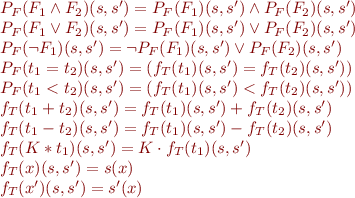Compositional VCG
Let  be formulas and
be formulas and  a command of our language using variables
a command of our language using variables  . To check
. To check  we compute formula
we compute formula  containing
containing
 specifying the semantics of c_1, that is, formula
specifying the semantics of c_1, that is, formula  such that
such that

Denote the truth value of formula in two states by  (predicate for the formula) using an auxiliary definition of
(predicate for the formula) using an auxiliary definition of  (function for the term):
(function for the term):

Then we can construct formula  such that
such that  . Denote such formula
. Denote such formula  by
by  .
To can then represent the validity of a Hoare triple
.
To can then represent the validity of a Hoare triple

by formula

Rules for Computing Formulas for Commands
Therefore, to prove Hoare triples, we just need to compute for each command  the formula
the formula  . We next show how to do it. These rules all follow from the semantics of our language.
. We next show how to do it. These rules all follow from the semantics of our language.
Assignment

Assume

Havoc

For simplicity of notation, in the sequel we work with state that has only one variable, x.
Union
Note

Therefore,
![Equation \begin{equation*}
F_c(c_1 [] c_2) = F_c(c_1) \lor F_c(c_2)
\end{equation*}](/w/lib/exe/fetch.php?media=wiki:latex:/img269b1545ef2e795d10a6f4fb2b738928.png)
Sequential composition
Note that
![Equation \begin{equation*}
\{(\vec x,\vec x') \mid F_1 \} \circ \{(\vec x,\vec x') \mid F_2 \} = \{ (\vec x,\vec z) \mid F_1[\vec x':=\vec z] \} \circ \{ (\vec z,x') \mid F_2[\vec x:=\vec z] \} = \{ (\vec x,\vec z) \mid \exists \vec z. F_1[\vec x':=\vec z] \land F_2[\vec x:=\vec z] \}
\end{equation*}](/w/lib/exe/fetch.php?media=wiki:latex:/img1d94d9d5f796d15845ef91b3abc9ad1f.png)
Therefore,
![Equation \begin{equation*}
F_c(c_1\ ;\ c_2)\ =\ (\exists \vec z. F_c(c_1)[\vec x':=\vec z] \land F_c(c_2)[\vec x:=\vec z])
\end{equation*}](/w/lib/exe/fetch.php?media=wiki:latex:/imga41547545cb90cdc5ec4b8af8da159c3.png)
Above, ![Math $F_c(c_1)[\vec x':=\vec z]$](/w/lib/exe/fetch.php?media=wiki:latex:/img028c2cb5e5865679e5159103b3b2b9cd.png) denotes taking formula
denotes taking formula  and replacing in it occurrences of variables
and replacing in it occurrences of variables  by variables
by variables  .
.
To avoid re-using variables, introduce always a fresh variable as  and denote it
and denote it  .
.
Using Computed Formulas
Note: the result will be disjunctions of such existential quantifications. We can always move them to top level.
Resulting formula:

which is equivalent to

Conclusions: we can just generate fresh variables for intermediate points and prove the validity of the resulting quantifier free formula  .
.
Optimizations: assignments and assume statements generate equalities, many of which can be eliminated by one-point rule

Example
Take the program in the example below:
(if (x < 0) x=x+1 else x=x); (if (y < 0) y=y+x else y=y);
It translate into the following relation:

By distribution of composition over union the relation above becomes:

It can be easily proven that  :
:

We can take all the terms of the union one by one as in the following small example:

Using valid formulas we can move the existential quantifiers outside the formula.
However, we can avoid expanding all paths and instead compute relations by following program structure.
Size of Generated Formulas
The compositional approach generates a formula polynomial in the size of the program. Indeed, fix the set of variables  . Then:
. Then:
- the size of formula for each basic command is constant
- non-deterministic choice is disjunction
- sequential composition is conjunction (along with renaming that does not affect size–or affects at most
 )
)
Moreover, formula generated in such a way looks very much like the program itself, converted to static single assignment form, see